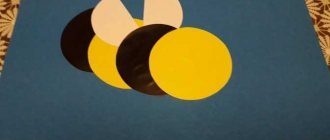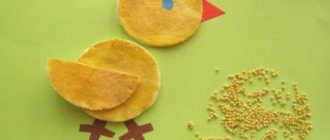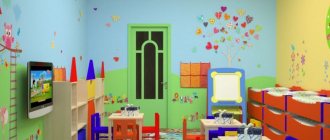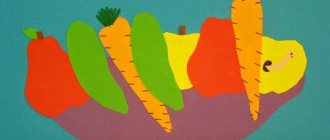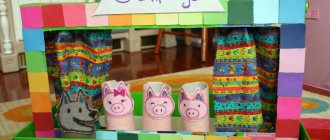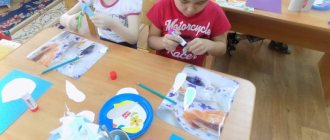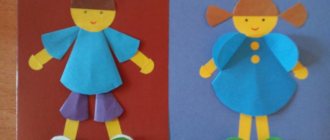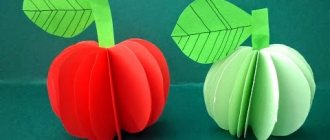- What is an application?
- How is the application useful for a child?
- A little about the types of applications
- Applications made from colored paper for children. What paper is needed for work?
- Circle applique ideas
- A few more volumetric applications
- Applications made from colored paper using templates
- A few more themes for colored paper applique
In this article you will get acquainted with applique, its types and find tips on creating children's crafts and ideas for them.
What is an application?
Applique is one of the types of arts and crafts designed to decorate the objects around us. We first encounter it in childhood, when an ordinary sheet of paper falls into our hands. That’s when miracles begin, because applique for a child is a kind of exciting game, magic, where he can create images by cutting, tearing, applying or combining materials on a base - a background.
Standard classification
There are many types of this handmade, among which three main ones can be distinguished:
— decorative applique (created on the principle of combining various elements of decoration);
- subject (pictures made using this technique consist of independent images - birds, trees, butterflies, etc.);
- plot (depicts a certain action or event - snowfall, family walk, dog playing with a ball).
This is the standard classification of this needlework. In addition to the items listed above, there are many other types of such crafts. Non-traditional applique can be performed using the following techniques.
How is the application useful for a child?
Children in early childhood (from about 1 year old) begin to be interested in this type of activity. This is precisely one of the opportunities to develop a child’s fantasy and imagination, study colors and their combinations, as well as the shapes of objects, and develop fine motor skills. Applique classes encourage the development of a child’s thinking processes; he creates a whole from several parts and learns to divide the whole into elements. And, of course, such creativity contributes to the development of speech and spending time together.
By doing appliqué, a child masters the skills of working with paper, scissors and glue, becomes familiar with the properties of paper, learns to work with simple drawings and diagrams, reads symbols and creates a complete image.
Ribbons and fabric
Tape. Using this method, it is possible to create not one or two identical figures, but any number of them. They can be tied together into a long garland or separated from each other. To make such a craft, you need a large sheet of paper. Fold it like an accordion, draw the outline of the future part on the top layer and cut it out, covering all levels of the material.
Fabric. This applique belongs to a variety of embroidery. The process of working on it consists of attaching elements made of similar material to a fabric base. The parts are secured by sewing or gluing. Knitted appliques are made on the same base material. To create such a craft, you must have some skills and dexterity. In particular, you need to be able to carefully cut out parts (the fact is that working with fabric is more difficult than working with paper). You also need to take into account that the edges of parts can delaminate and crumble, which complicates the creative process.
A little about the types of applications
By topic, the following types of applications can be distinguished:
- Subject - a simple type of application for children. An element is cut out of the material and glued to the base.
- Subject - the image no longer consists of one, but several links that make up an event or action in the background.
- Decorative - forms a repeating pattern that is used to decorate albums, frames and household items.
Paper is the main material for applique. However, in addition to it, you can use other materials, whatever your imagination allows: fabric, leather, multi-colored beads, seed beads, woolen threads, leaves, seeds, cereals and much more.
By color, the applique can be colored, black and white or single color.
Depending on the volume, flat and volumetric applications are distinguished.
Overhead, cut-off, silhouette, modular, ribbon... and this is not all types of applique!
And to understand how diverse this art technique is, it is enough to get acquainted with the most popular and interesting types of children's applications, examples of which are given below.
Entertaining the kids
Applications for children represent an important stage in the formation of thinking. Working with simple materials, the child learns to think creatively, see the complex in the simple, fantasize and think in images.
The first children's applique made of plasticine promotes the development of sensory motor skills. By kneading a pliable piece under his fingers, the child sends signals to the brain responsible for the speech apparatus. Working with the mother, the child learns to draw analogies between the drawing and the result obtained. In addition, the bond between child and parent is strengthened.
Paper appliqué is also mastered with children aged three to four years old. It is important to arouse interest, because a child is unlikely to simply understand that a simple sheet of colored paper can turn into a zebra or a kitten.
Applications for children should not be too complicated. You should start with simple elements that do not require additional effort. For example, you can depict a house - for this, the elements are first cut out. A square is cut for the walls, a triangle for the roof. Then the child, under the guidance of an adult, can glue the blanks in the specified sequence. For children, the process by which a recognizable image is formed from unknown parts is a real miracle.
Applications made from colored paper for children
If you want to do any work, take into account that the proposed examples of applications have different levels of complexity and require different amounts of time.
For most crafts you will need:
- Colored paper
- Cardboard
- Glue
- Scissors
- Markers
What paper is needed for work
The beauty of the applique depends not only on carefully cutting out the parts and carefully gluing them to the background, but also on the materials used. Here are some tips for choosing paper for crafting:
- It is better to choose medium density sheets.
- Unlike gloss, fingerprints and glue marks will not be visible on matte paper.
- You can use thick matte paper made for printers.
- Textured paper focuses attention on the details of the craft.
- Foil sheets will make the applique or its details close to reality.
- When using self-adhesive, no glue is needed.
- Drawing paper is suitable for creating a template.
- Cardboard is best used as a background for applications.
Circle applique ideas
If the work is made entirely of circles, it will turn out unusual and interesting. For example, in order to create a fish, you will need a large circle of paper.
Two smaller circles, bent in half, form a tail at the edge. Many circles of the same size, also folded in half, will create the illusion of scales and fins.
When the elements are glued to the base, they form a three-dimensional appliqué. From such circles you can create many other animals or many plants.
A few more volumetric applications
Ladybug is easy to make. Cut out two circles from red paper and two half-ovals from black. We bend the circles in half and glue one half onto the base. We attach the semi-oval head in the middle above the circles. All that remains is to draw black dots on them and add eyes and antennae to everything.
In this way, you can make voluminous “fruit” and “berry” applique – apples, cherries.
Applications made from colored paper using templates
A template is a device for marking one or several parts of a drawing, repeating their shape.
Applications “Summer”, “Autumn”, “Winter”, “Spring” open up enormous scope for the development of imagination.
In a plot applique, you can take any fairy tale plot and break it down into small elements. Birds, butterflies, animals, clouds, flowers are possible templates for children when creating a summer applique.
You can make a beautiful basket with flowers. You need to prepare a basket template that will serve as the background for the craft. We glue the basket onto cardboard so that it holds well. Using a template, cut out circles of bright colors from a sheet of paper: yellow, red, blue. The middle of the circle needs to be pressed with a pencil and glued in place. To get more voluminous flowers, glue a smaller circle in the middle in the same way.
A few more themes for colored paper applique
The broken applique of lilac flowers turns out to be so lush that it looks quite realistic.
It is worth using white, pink or purple napkins. You need to cut out a silhouette of a pre-designed shape and size of the inflorescence from a colored napkin. Then glue it onto the base. Next, cut the napkins into small squares. We crumple some of them right away, others we also crumple, but first we tear them into pieces. We glue the lumps to the silhouette so that there is no gap between them. The flower is ready!
By drawing an outline in advance and choosing the necessary colors, you can create a masterpiece from pieces. For example, for a bear cub you will need paper in brown, black, yellow, white and red. The broken pieces should be approximately the same size and fit together like a puzzle.
For the next application, you need to place the child’s palm on a sheet of paper and circle it. We cut it along the contour and glue it onto the base, except for the fingers that will hold the bouquet (as shown in the photo).
Next, cut out multi-colored flowers and glue them with the centers onto the bouquet. We bend our fingers and... the craft is ready!
Applications made from colored paper are a creative process through which children learn about the world around them and acquire a lot of skills. There are many varieties of applications, the main thing is that it brings genuine joy and interest to the person who creates them. Create, fantasize, experiment, it's so simple!
We turn to nature for help
Decorative applique made from straw. Such crafts look very stylish: the rays of the sun play in their golden lines. The fact is that the surface of this material is glossy and perfectly smooth, thanks to the longitudinal fibers of which it consists. These microscopic strips are capable of maximizing light reflection when placed in the correct position in relation to the sun.
Compose the shapes of your composition from parts that lie at different angles relative to the light source. In this case, you can ensure that each element shines and shimmers beautifully. Using this technique, you can make entire paintings, as well as decorate bookmarks, various boxes and frames.
From the herbarium. Dried flowers, grass and leaves are very popular materials for creating crafts. These parts are easily accessible to schoolchildren and small children. The appliqué patterns are very easy to make and don’t require a lot of work. But, before you begin the process of creating crafts, you need to take a walk and collect the necessary materials. This is not only an interesting and exciting activity, it also instills in children a love and respect for nature. In addition, such walks are very useful, because they take place in the fresh air.
Photo ideas for interesting children's applications made from colored paper
leave a comment
Making chamomile: master class
It will take you a maximum of half an hour to create a classic chamomile. Start by drawing the outlines of the future petals on white paper. They should have an elongated oval shape. Leave a little space around the edges so that you can bend each piece later. In this flower the petals are arranged in several tiers. To work, you will also need green paper for the background and a little yellow for the core.
First, cut out 16 large petals, and then 12 slightly smaller ones. Stick their bases onto the background to form a circle. Lay out the bottom tier with larger ovals, and the top with those that are smaller in size. The finishing touch is to glue the circle in the center, which will serve as the core.
You can try a more interesting option by tearing the yellow leaf into small pieces. Lubricate the middle of the flower with glue and sprinkle this area with the resulting scraps. Make sure they form an even circle. This method will help you make a fluffy center for a flower.
Learning shapes
Another creative option is appliqué from figures. This kind of work develops children’s imagination and thinking well. In addition, they begin to study and remember the shapes that various objects have. These crafts can be very simple or more complex in structure and number of parts. But they are always based on the principle of using simple geometric shapes.
For example, a house can be made from a square that will go on the wall, a triangle on the roof, and rectangles on the windows and door. To create a flower, butterfly or caterpillar you will need circles. Any animal can be made from ovals of different sizes. A simple and cute applique postcard created using this technique can be a wonderful gift from a child to a parent or friend for any occasion.
